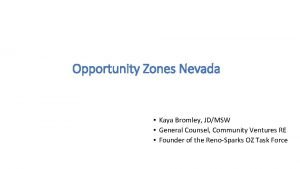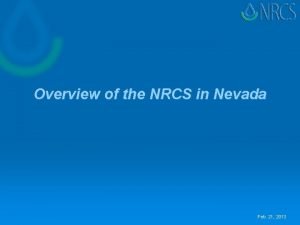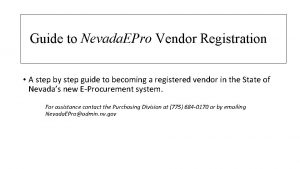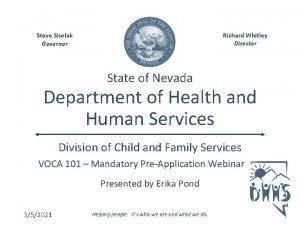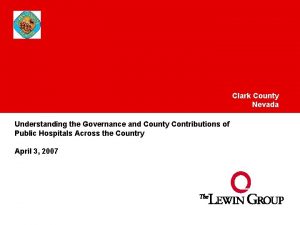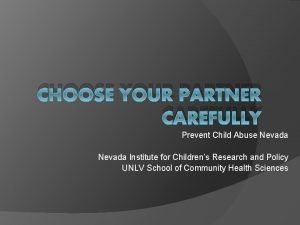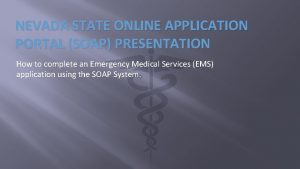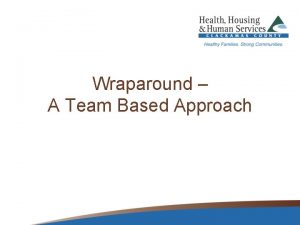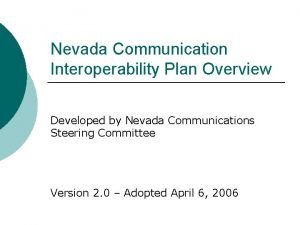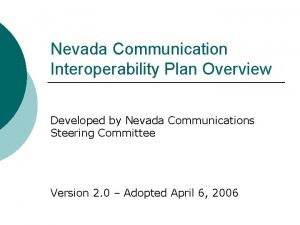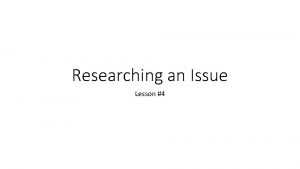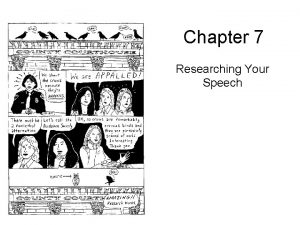Researching Wraparound in Nevada Overview of the Youth




























































- Slides: 60

Researching Wraparound in Nevada Overview of the “Youth and Family Supports Study” Funded by the National Institute of Mental Health State MH Consortium Meeting May 22, 2008 Reno, Nevada Eric J. Bruns, University of Washington Ramona Denby Brinson, University of Nevada, Las Vegas Michelle Ramey, University of Nevada, Las Vegas ebruns@u. washington. edu Ramona. denby@unlv. edu 1 Michelle. Ramey@unlv. edu

Overview of this Presentation p p p Background: What works in children’s mental health? The role of Wraparound in achieving positive outcomes for youth and families What does it take to implement wraparound? n p The Nevada Youth and Family Supports Study n n n p p Research on “wraparound fidelity” Study goals Data still to come Opportunities for Nevada Data from the Study so far: Implementation of Wraparound in Nevada What next? 2

What is an “Evidence Based Practice”? A process of applying scientific knowledge about service practices to the situation of an individual child and family p Treatment procedures that have been shown to be effective through scientific evidence of some level of robustness* p *From Bruns, Hoagwood et al. (in press). State implementation of evidence based practice, Part 2: Recommendations for research and policy. Journal of the American Academy of Child and Adolesc. Psychiatry. 3

We have treatments with evidence for effectiveness for… p p p Anxious or Avoidant Behaviors Attention and Hyperactive Disorders Autistic Spectrum Disorders Disruptive and Oppositional Behaviors Self-harming Behaviors p p p p Assaultive and Aggressive Behaviors Sexually Aggressive Behaviors Traumatic Stress Interpersonal problems Substance use Delinquent behavior History of abuse and neglect 4

Unfortunately, major barriers to using EBPs in “real world” practice p Complexity of child and family needs n n n p Multiple and overlapping child problem areas Unmet basic family needs Many providers, many requirements, little coordination Lack of full engagement and partnership with families n n Families are overwhelmed, do not feel their priority needs are being addressed Leads to treatment dropouts, missed opportunities for positive change, bad outcomes 5

Family Drives the process Theory of change: Why wraparound may be critical to positive outcomes Facilitator, Team, Flex funds, Service array Getting Support Teamwork & coordination Achieving Goals Better plans Optimism & Hope Better follow through Natural supports Self. Efficacy Positive Outcomes! 6

Promising Outcomes for Communities using the Wraparound Process 7

Outcomes – Wraparound Milwaukee Average daily Residential Treatment population reduced from 375 placements to 70 placements n Psychiatric Inpatient Utilization reduced from 5000 days per year to under 200 days (average LOS of 2. 1 days) n Reduction in Juvenile Correctional Commitments from 325 per year to 150 (over last 3 years) n 8

Results from Nevada: Living in less restrictive, more community based settings 9

Results from Nevada: Functioning better in the community 10

Results from Oklahoma: Getting to permanency 11

Results from Oklahoma Supporting re-integration of adult prisoners 12

OK, so the “theory of change” makes good sense. Families like wraparound The model is being better understood. The research base continues to grow… So, what is the challenge? 13

A National Review of Wraparound Teams Showed (Walker, Koroloff, & Schutte, 2003) p p p Less than 1/3 of teams maintained a plan with team goals Less than 20% of teams considered >1 way to meet a need Only 12% of interventions were individualized or created just for that family p p p All plans (out of more than 100) had psychotherapy Natural supports were represented minimally n 0 natural supports 60% n 1 natural support 32% n 2 or more natural support 8% Effective team processes were rarely observed 14

Hospitable System (Policy and Funding Context) Supportive Organization (lead and partner agencies) Effective Team 15

System and organizational supports for wraparound p p p Community Partnership. Community ownership of wraparound is built through collaborations among key stakeholder groups. Collaborative Action. Stakeholders involved in the wraparound effort take concrete steps to develop concrete policies, practices and achievements. Fiscal Policies and Sustainability. The community has developed fiscal strategies to meet the needs of children participating in wraparound and methods to collect and use data on expenditures. 16

System and organizational supports for wraparound p Access to Needed Supports & Services. There are mechanisms for ensuring access to the services and supports that teams need to fully implement their plans p Human Resource Development & Support. The system supports wraparound staff and partner agency staff to fully implement the wraparound model. p n Low caseloads n The right job descriptions n Training and coaching n Good supervision, etc Accountability. The community has mechanisms to monitor wraparound quality and outcomes. 17

Monitoring quality of implementation of child and family teams Have facilitators and team members fill out activity checklists p Look at plans of care and meeting notes p Sit in on and observe team meetings p Ask the people who know– parents, care givers, youth, facilitators, program heads p 18

Wraparound Fidelity Assessment System WFI-4 – Wraparound Fidelity Index WF evi Do c. R WFAS ew M I-4 TO TOM – Team Observation Measure CSW I CSWI – Community Supports for Wraparound Index DOC - Document Review Measure 19

Summary: What Leads To Outcomes? Program and System Supports Training, Coaching, and Quality Assurance Sticking to the wrap principles in service delivery Improved Child and Family Outcomes 20

A summary of research on wraparound implementation There are connections between system support for wraparound implementation and fidelity p There are connections between wrap fidelity and child and family outcomes p We are beginning to get a sense of what “high” fidelity is in terms of scores on tools like the WFI p BUT: The research is still preliminary, and the field is looking for additional evidence p 21

Studying Wraparound Implementation in Nevada 22

The “Outcomes of Wraparound in Nevada” Study The first NIMH-sponsored controlled research study of wraparound p Examines the differences in outcomes, treatment processes, and costs of wraparound vs. case management p Tests psychometrics of the Wraparound Fidelity Index and other fidelity tools p A chance to use data on treatment processes, costs, and outcomes to inform implementation of services for youth with SED in Nevada p 23

Major Research Questions Does implementing wraparound for a youth with SED result in a different service process than implementing intensive CM? p Does the wraparound process lead to better outcomes? p What are the costs of the two models? p How important is “wraparound fidelity” to achieving outcomes? p 24

Study population 150 children and youth (age 6 -17) with SED that requires intensive intervention p Fee for service Medicaid eligible p N=75 assigned to Wraparound condition as delivered by WIN and CCS p N=75 assigned to CM delivered by Mojave p 25

What data is the Youth and Family Supports Study providing? p Child Behavior and Functioning n n n p Services received n n p Strengths and Difficulties Questionnaire (SDQ) Child and Adolescent Functional Assessment Scale (CAFAS) Child Status Report – Residential Setting; Child Welfare, School, and Juvenile Justice Outcomes* Services Assessment for Children and Adolescents Case Management Function Form Service processes and satisfaction n n Parent and Youth Satisfaction Questionnaires Working Alliance Inventory Family Empowerment Scale Glisson Organizational Social Context Scale * Also being collected via admin. data from DCFS, DJJS, CCPSS 26

Additional data from the Youth and Family Supports Study p Fidelity to the wraparound model n n p From interviews of the WFI From team observations from the TOM System support for wraparound n Community Supports for Wraparound Inventory (CSWI) Connections to resources – who is on their team? What is in their plan? p Whether services are making a difference in areas that matter to families (e. g. , optimism; level of empowerment; lost days at work) p 27

Progress report 28

Study Enrollment to date 29

Characteristics of YFSS Participants N=48 total (41 active) cases with baseline data collection completed as of April 2008 30

Demographics p p p Male = 22 (46%) Female = 26 (54%) Age n n p Mean = 11. 42 (SD = 3. 35) Range = 6 -17 Race n n African American = 16 (36%) White = 12 (27%) Hispanic = 7 (16%) Mixed Race = 7 (16%) p n p AA & White = 3; AA & Hispanic = 4 Native American = 1 (5%) Biological parents w/parental rights = 15 (31%) 31

Referral and study information p Referral source (to services) n n p Language spoken at home (other than English) n p Child welfare = 37 (79%) Self = 7 (15%) School = 2 (4%) Mental health agency/provider = 1 (2%) Spanish = 2 (4%) Assignment to services n n n ICM = 20 WIN = 20 CCS = 8 32

Placement and Placement History p Current placement n n n p Foster Care = 18 (44%) Biological or Adoptive Parents = 11 (27%) Group Home or Shelter = 5 (12%) Relative = 5 (10%) Residential job corps/vocational = 2 (5%) Previous 6 mos n n n Group Home or Shelter Care = 8 (20%) Residential Treatment = 4 (10%) Psychiatric Hospital = 3 (7%) 33

DSM Diagnoses assigned (N=30) Adjustment Disorders = 10 (33%) p ADHD = 8 (26%) p Mood Disorders (incl. Depression/Bipolar) = 7 (22%) p Disruptive disorders (incl. ODD/CD) = 7 (22%) p Post Traumatic Stress = 4 (13%) p Attachment Disorders = 2 (7%) p Developmental Disorders = 2 (7%) p Substance Abuse Disorder = 1 (3%) p Learning Disorder = 1 (3%) p Psychotic Disorder = 1 (3%) p 34

Number of Diagnoses Assigned (N=30) 35

CAFAS Functioning Subscales: Percent of youth with “moderate to severe” needs 36

Findings on Wraparound Implementation in Nevada from the YFSS 37

Baseline Fidelity data assessment (200607) p Vision for the project: n n Inform high quality practice, Create a culture in which data is used to inform decision making, Ensure a better understanding of wraparound on the part of families and providers, and Help “make the case” for better support for wraparound implementation in Nevada. 38

Baseline Fidelity data assessment (200607) p Methods: n n Random sample of N=90 youth drawn from WIN and CCS in Clark Co Data collection completed for: p Wraparound Fidelity Index (WFI) § N=59 youth § 139 interviews completed across the 3 respondent types p Team Observation Measure (TOM) § N=27 team meetings observed by UNLV and DCFS staff p Document Review Measure (DRM) § N=65 case files reviewed by UNLV and DCFS staff 39

Results of Fidelity Assessment: Strengths of wraparound implementation p Cultural & Linguistic Competence. n p Collaborative Efforts. n n p Those serving on WIN and CCS wraparound teams demonstrate cooperation and shared responsibility for developing, implementing, monitoring, and evaluating wraparound plans. In particular, effective team brainstorming of strategies was noted in the WFI. Persistence. n n p WIN and CCS teams have shown respect for the values, preferences, beliefs, culture, and identity of the child and family, and their community. Items for this indicator were extremely high across all instruments used. Data indicate WIN and CCS wrap teams persist in working towards goals included in the wraparound plan, despite challenges presented by enrolled families. Teams successfully maintain youth in the community, and ensure some members of the team will be available after formal wraparound is finished. Other strengths n Working to keep the youth in the least restrictive environment, encouraging youth and family voice, maintaining a positive team culture and having team members who share responsibility for designing and implementing the child and family’s plan 40

Results of Fidelity Assessment: Needs for improvement p Natural Supports. n p Team Based. n p WIN and CCS wrap teams are not consistently tying the goals and strategies of the wraparound plan to measurable indicators, measuring progress, using assessment of progress to guide follow-through. Crisis Planning. n p The family and youth are not typically picking who will be on their child and family team, and there are unclear roles for natural & community supports on teams. Outcome Based Process. n p Seeking out and encouraging full participation of individuals from family members’ networks of interpersonal and community relationships. Many records did not include crisis plans that based on functional assessments for the children and youth and did not have strategies for preventing the crisis or detailed steps to be taken. Other needs for improvement n n n Strategizing ways to involve the youth and family in community activities Transition planning Clarity of roles between DCFS and child welfare staff 41

Summary scores: Wraparound Fidelity Index Compared to another state + “high fidelity” benchmarks 42

More Results on Wrap Implementation: From the Community Supports for Wraparound Inventory 43

The Community Supports for Wraparound Inventory p The 40 items are grouped within 6 themes: 1. 2. 3. 4. 5. 6. p Community partnership Collaborative action Fiscal policies Service array Human resource development, and Accountability Respondents complete the 40 items by rating the development of supports in their community or program on a 5 point scale n 0 = “least developed” and 4 = “fully developed” 44

Method 31 stakeholders in the Nevada system of care were identified and invited to complete the CSWI p These stakeholders were sent a link to a web survey version of the CSWI p 22 nominated respondents completed the CSWI (71%), 4 declined to complete the CSWI (13%), and 5 did not respond (16%) p 45

Respondents Mean total experience with wraparound = 6. 6 years Mean years in current wrap program = 3. 6 years 46

Respondents: Experience by Role in Wraparound Implementation Role Number* Mean Experience in Role Family/youth on team 4 5. 8 years Natural support on team 8 6. 0 years Parent partner/advocate 7 5. 3 years Facilitator/Care co-ord. 9 4. 1 years 12 6. 5 years Wrap supervisor/coach 8 3. 3 years Trainer/Consultant 9 2. 2 years 10 5. 2 years Higher admin/Policy 4 5. 8 years Researcher 4 1. 5 years Professional on team Manager/administrator *This column total sums to more than total respondents due to people having filled multiple roles over time. 47

CSWI Results: Averages by Theme for NV Least developed Midway Fully developed 48

Cross-Site Comparison: Nevada (site 2) versus 5 other Wrap initiatives 49

Results p Greatest relative strength** Item 2. 1 Community Principles and Values Mean Rating 2. 4 50

Other areas of relative strength: Moderate development Item Mean Rating 5. 4 Professional development 2. 11 5. 5 Supervision 2. 11 1. 1 Community team 2. 09 1. 2 Empowered community team 2. 09 2. 3 Proactive Planning 2. 06 2. 8 State interface 2. 06 2. 5 Partner agency staff preparation 2. 06 51

Other areas of relative strength: Moderate development Item Mean Rating 2. 2 High-level leadership 1. 89 2. 7 Single plan 1. 89 5. 3 Caseload sizes 1. 89 1. 5 Agency support 1. 86 3. 6 Sustained funding 1. 82 5. 2 Agency job expectations 1. 76 5. 1 Wraparound job expectations 1. 76 2. 6 Information sharing 1. 74 1. 3 Family voice 1. 73 4. 1 Program access 1. 72 6. 2 Range of outcomes 1. 65 6. 1 Outcomes monitoring 1. 63 52

Areas of modest development… Item Mean Rating 6. 1 Outcomes monitoring 1. 63 6. 3 Wraparound quality 1. 59 2. 4 Joint action steps 1. 59 1. 7 Community representativeness 1. 55 6. 4 Plan fulfillment 1. 53 4. 5 Service/support quality 1. 53 4. 2 Service/support availability 1. 50 4. 4 Choice 1. 50 3. 5 Fiscal flexibility 1. 47 5. 6 Compensation for wraparound staff 1. 41 6. 6 Satisfaction monitoring 1. 40 4. 3 Building natural and community supports 1. 39 53

Least development Item Mean Rating 6. 5 Grievance procedure 1. 29 1. 6 Community stakeholders 1. 23 4. 6 Crisis response 1. 22 6. 7 Addressing barriers 1. 20 3. 1 Fiscal understanding 1. 13 3. 2 Removing fiscal barriers 1. 07 3. 3 Collective fiscal responsibility 0. 88 3. 4 Fiscal monitoring 0. 87 1. 4 Youth voice 0. 86 54

Results: “Big Picture” summary WIN program’s strengths are in the first two themes– Community Partnership (except youth voice) and Collaborative Activity p Least developed area: fiscal policies and sustainability p 55

Results: Positive Comments from Respondents p Foundations of collaboration n n p All agencies are at the table talking. When the systems work together, family and children benefit. In addition, when the agencies are committed to the wraparound process, work satisfaction increases, positive collaborative efforts increase and again, the family and children benefit The wraparound model n n Using a team approach--Family driven, strength based, family voice and choice The strength-based approach, family voice and choice has empowered the families I've provided services. Along with The Child and Family Team Approach. 56

Results: Positive Comments (continued) p Building capacity for wraparound practice n p Even without good system supports, wraparound appears to show good outcomes - if there is good supervision of staff that ensures the highest fidelity Building system capacity n n There is a stable infrastructure for the wraparound program. There are… beginning efforts to implement continuous quality improvement strategies for wraparound. I have seen through the past four years more support to really do the model with our families. More people know about wraparound. 57

Results: Comments about Challenges p Fiscal issues, particularly lack of funding for support services n n n p Lack of funding for Family Support services. Funding for non-governmental organizations continues to be a problem. Fiscal policies and practices present barriers to effective implementation of wraparound. There is a grossly inadequate capacity to provide the supportive services necessary for wraparound (therapies, psychiatric services, mentoring, behavioral support services, etc. ) Collaboration between agencies n n n Cross-Agency collaboration and full understanding of the wraparound process. . Conflicting philosophies among public agencies. Lack of understanding of what the wraparound process is both in public and private system partner agencies and therefore, inadequate buy-in and support for the process. Getting everyone's buy in and to agree on one process in implementation. 58

So: What are next steps? p The Youth and Family Supports Study will continue to provide information on: n n n p Wraparound Implementation and Fidelity Satisfaction and services being received Outcomes for 150 youth in the system in the areas of home, community, and school Progress being made by youth and families toward their wraparound goals, permanency, and other outcomes Costs of serving youth and cost-savings Question: What additional information will the Consortium benefit from? n By when? Formatted how? 59

Next steps for the Consortium? p When considering how best to support implementation or expansion of wraparound, consider: n n n Leadership Infrastructure and oversight Fiscal and other Policies Collaboration across stakeholders and agencies Social Marketing Professional development: Support for high quality supervision, training, and coaching of staff 60
 Wraparound in nevada
Wraparound in nevada Wraparound milwaukee
Wraparound milwaukee Researching wan technologies
Researching wan technologies Researching
Researching Researching the corruption
Researching the corruption Chapter 3 researching careers
Chapter 3 researching careers Cái miệng bé xinh thế chỉ nói điều hay thôi
Cái miệng bé xinh thế chỉ nói điều hay thôi Hát kết hợp bộ gõ cơ thể
Hát kết hợp bộ gõ cơ thể Cách giải mật thư tọa độ
Cách giải mật thư tọa độ Tư thế ngồi viết
Tư thế ngồi viết Voi kéo gỗ như thế nào
Voi kéo gỗ như thế nào Thẻ vin
Thẻ vin V cc cc
V cc cc Thơ thất ngôn tứ tuyệt đường luật
Thơ thất ngôn tứ tuyệt đường luật Các châu lục và đại dương trên thế giới
Các châu lục và đại dương trên thế giới Từ ngữ thể hiện lòng nhân hậu
Từ ngữ thể hiện lòng nhân hậu Hổ sinh sản vào mùa nào
Hổ sinh sản vào mùa nào Thế nào là hệ số cao nhất
Thế nào là hệ số cao nhất Diễn thế sinh thái là
Diễn thế sinh thái là Vẽ hình chiếu vuông góc của vật thể sau
Vẽ hình chiếu vuông góc của vật thể sau Ng-html
Ng-html 101012 bằng
101012 bằng Lời thề hippocrates
Lời thề hippocrates Tư thế worm breton
Tư thế worm breton đại từ thay thế
đại từ thay thế Quá trình desamine hóa có thể tạo ra
Quá trình desamine hóa có thể tạo ra Công thức tiính động năng
Công thức tiính động năng Khi nào hổ con có thể sống độc lập
Khi nào hổ con có thể sống độc lập Thế nào là mạng điện lắp đặt kiểu nổi
Thế nào là mạng điện lắp đặt kiểu nổi Dạng đột biến một nhiễm là
Dạng đột biến một nhiễm là Bổ thể
Bổ thể Vẽ hình chiếu đứng bằng cạnh của vật thể
Vẽ hình chiếu đứng bằng cạnh của vật thể Nguyên nhân của sự mỏi cơ sinh 8
Nguyên nhân của sự mỏi cơ sinh 8 độ dài liên kết
độ dài liên kết Thiếu nhi thế giới liên hoan
Thiếu nhi thế giới liên hoan Hát lên người ơi
Hát lên người ơi điện thế nghỉ
điện thế nghỉ Một số thể thơ truyền thống
Một số thể thơ truyền thống Trời xanh đây là của chúng ta thể thơ
Trời xanh đây là của chúng ta thể thơ Bảng số nguyên tố lớn hơn 1000
Bảng số nguyên tố lớn hơn 1000 Tỉ lệ cơ thể trẻ em
Tỉ lệ cơ thể trẻ em Tia chieu sa te
Tia chieu sa te đặc điểm cơ thể của người tối cổ
đặc điểm cơ thể của người tối cổ Các châu lục và đại dương trên thế giới
Các châu lục và đại dương trên thế giới Hệ hô hấp
Hệ hô hấp ưu thế lai là gì
ưu thế lai là gì Môn thể thao bắt đầu bằng chữ f
Môn thể thao bắt đầu bằng chữ f Tư thế ngồi viết
Tư thế ngồi viết Nevada opportunity zones
Nevada opportunity zones Nrcs nevada
Nrcs nevada Nevada e pro
Nevada e pro Nevada eits
Nevada eits Richard whitley nevada
Richard whitley nevada Nevada department of taxation modified business tax return
Nevada department of taxation modified business tax return The 2000 population of las vegas nevada was 478 000
The 2000 population of las vegas nevada was 478 000 Cook county nevada
Cook county nevada State of nevada department of business and industry
State of nevada department of business and industry Choose your partner carefully
Choose your partner carefully State of nevada department of business and industry
State of nevada department of business and industry Nevada ems soap
Nevada ems soap Yogurt whole milk wic
Yogurt whole milk wic
















































